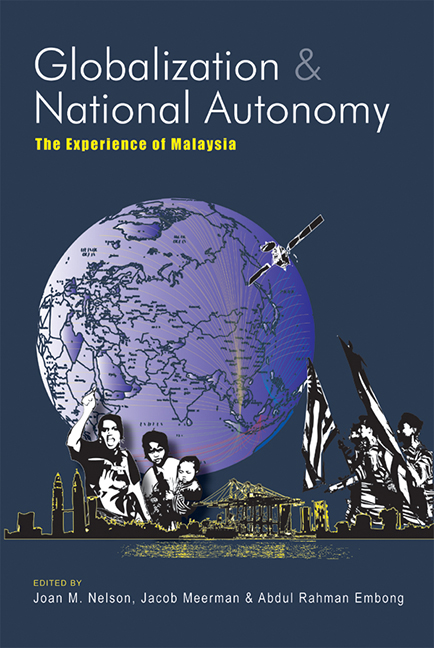Book contents
- Frontmatter
- Contents
- List of Abbreviations
- List of Tables and Figures
- Preface
- Contributors
- Chapter 1 Introduction
- Chapter 2 Developmentalist State in Malaysia: Its Origins, Nature, and Contemporary Transformation
- Chapter 3 The Look East Policy, the Asian Crisis, and State Autonomy
- Chapter 4 The Malaysian Success Story, the Public Sector, and Inter-ethnic Inequality
- Chapter 5 Poverty Eradication, Development, and Policy Space in Malaysia
- Chapter 6 Trade Liberalization and National Autonomy: Malaysia's Experience at the Multilateral and Bilateral Levels
- Chapter 7 Malaysia's Education Policies: Balancing Multiple Goals and Global Pressures
- Chapter 8 Malaysia's Healthcare Sector: Shifting Roles for Public and Private Provision
- Chapter 9 Globalization, Islamic Resurgence, and State Autonomy: The Response of the Malaysian State to ‘Islamic Globalization’
- Chapter 10 The National Culture Policy and Contestation over Malaysian Identity
- Chapter 11 Conclusions
- Index
Chapter 3 - The Look East Policy, the Asian Crisis, and State Autonomy
Published online by Cambridge University Press: 21 October 2015
- Frontmatter
- Contents
- List of Abbreviations
- List of Tables and Figures
- Preface
- Contributors
- Chapter 1 Introduction
- Chapter 2 Developmentalist State in Malaysia: Its Origins, Nature, and Contemporary Transformation
- Chapter 3 The Look East Policy, the Asian Crisis, and State Autonomy
- Chapter 4 The Malaysian Success Story, the Public Sector, and Inter-ethnic Inequality
- Chapter 5 Poverty Eradication, Development, and Policy Space in Malaysia
- Chapter 6 Trade Liberalization and National Autonomy: Malaysia's Experience at the Multilateral and Bilateral Levels
- Chapter 7 Malaysia's Education Policies: Balancing Multiple Goals and Global Pressures
- Chapter 8 Malaysia's Healthcare Sector: Shifting Roles for Public and Private Provision
- Chapter 9 Globalization, Islamic Resurgence, and State Autonomy: The Response of the Malaysian State to ‘Islamic Globalization’
- Chapter 10 The National Culture Policy and Contestation over Malaysian Identity
- Chapter 11 Conclusions
- Index
Summary
This chapter puts forth the argument that the Look East Policy (LEP) launched in 1982 was essentially a rationale by the then Prime Minister Dr Mahathir Mohamad, to justify his vision of the New Economic Policy (NEP), a rationale greatly influenced by developments in both the international and domestic arenas. The perceived need for such a rationale illustrates an aspect of globalization affecting other countries as well as Malaysia: international currents of opinion and ideology influence investors’ decisions regarding attractive investment opportunities. Countries seeking autonomy in their choice of growth strategies, yet also desiring to attract foreign investment, may need to find ways to justify their choices that are acceptable to international investors.
Two aspects of the international situation had a great bearing on Malaysian policy: the ascendancy of the Thatcher-Reagan school advocating reduction of state involvement in the economy in order to promote economic growth, and the dazzling success of the Japanese model. These influences interacted with a domestic factor: the belief by Dr Mahathir that the NEP, which had been in existence for more than a decade, should enter a new stage. Dr Mahathir's formulation of the LEP essentially consisted of the introduction of Malaysia Incorporated, along the lines of his perception of Japan Incorporated. The LEP was actually quite a clever response to these international and domestic developments. Malaysia Incorporated was presented as a system where a particular form of state intervention could not only bring about social stability but also great economic growth. It seemed a plausible alternative to the Thatcher-Reagan approach. On a domestic level, the LEP put the priority on the development of private Malay entrepreneurs. This was a departure from the previous emphasis on the use of state enterprises, which served mainly to expand Malay employment and were not efficient, to implement the ends of the NEP.
Fifteen years later, the Asian crisis (AFC) in 1997 greatly eroded the Malaysia Incorporated rationale, because it brought about a contraction of the Malaysian economy (which should have been expanding according to the LEP rationale) and exposed the indebtedness of many high profile bumiputera businessmen created and developed as part of the LEP.
- Type
- Chapter
- Information
- Globalization and National AutonomyThe Experience of Malaysia, pp. 59 - 75Publisher: ISEAS–Yusof Ishak InstitutePrint publication year: 2008



